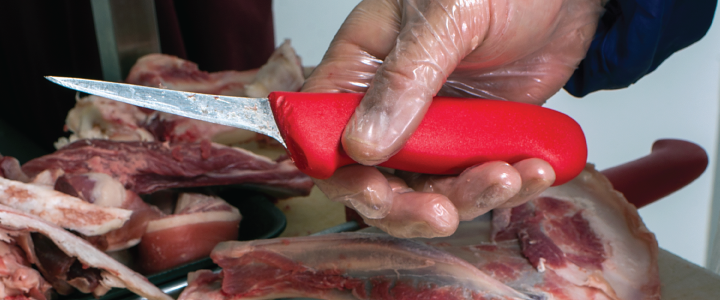Our comprehensive guide to boning knives for butchery
If you’re a professional butcher, you may well have already heard the question: ‘do you actually need a boning knife?’ Obviously, it’s not a question with a universal answer – it really depends on the quantities and types of meat you’re handling on a day to day basis. Essential or not, though, it’s an undeniably useful addition to a butcher’s arsenal; a perfect tool for the jobs that bulkier, heavier knives can’t always tackle. Below, we answer all your questions about boning knives!
 Of course, providing a firm grip comes before all else. Above all, the handle of boning knife needs to be comfortable in your hand. Some jobs require a particularly firm grip, for example when you’re de-boning a cut of lamb. Meanwhile, other jobs require a more delicate touch and therefore a lighter grip (such as filleting a fish). Finding a knife that feels the most comfortable for the task at hand is always a massive help in doing it quickly, effectively and efficiently.
Of course, providing a firm grip comes before all else. Above all, the handle of boning knife needs to be comfortable in your hand. Some jobs require a particularly firm grip, for example when you’re de-boning a cut of lamb. Meanwhile, other jobs require a more delicate touch and therefore a lighter grip (such as filleting a fish). Finding a knife that feels the most comfortable for the task at hand is always a massive help in doing it quickly, effectively and efficiently.
Stiff boning knives
The stiffer boning knives are perfectly suited to cutting into tougher, thicker cuts of meat such as beef or lamb, which might be harder to cut cleanly with more delicate, flexible knives. More often than not, stiff boning knives have straighter blades, the better for keeping the cut clean and accurate while keeping the amount of wastage to an absolute minimum.
Flexible boning knives
As great as the stiffer knives can be, some butchers find them a little unwieldy for more delicate cuts of meat such as fish or chicken, as they can be hard to use while doing more nitty-gritty jobs like filleting or de-boning. This is where flexible-bladed boning knives can really come into their own. As the name suggests, their ability to bend and flex without shattering allows them to cut round lighter corners and around more complex shapes, so that (for example) you’re always following the seams in the meat wherever possible.
Usually, flexible boning knives have slightly curved blades, to make it even easier to angle the knife into narrow gaps between the bones. A prime example of this sort of design can be seen in our BEW 6” Curved Boning Knife, which we’ll talk about in more detail below!
A quick note about the thickness of boning knives: Most boning knives are thinner than butcher’s knives as a general rule, but there can be a fair amount of variations between the thicknesses of individual boning knives, too. Obviously, the thinner a blade is, the more suitable it is for the most delicate tasks, but don’t forget that not all thin blades are necessarily flexible too!
 Fillet knives
Fillet knives
 BEW 6” Curved Boning knife
Our 6” curved boning knife is ideal for the more delicate jobs like those we’ve outlined above; removing bones from fish and poultry with the bare minimum of effort and wastage. As with many filleting knives, it has a gently curving blade to help you easily get into the little nooks and crannies that might be required to make a clean cut.
BEW 6” Semi Flexi Curved Boning knife
If you’re finding the task of making these delicate incisions more difficult than you think it needs to be, it’s well worth investing in a flexible-bladed boning knife. And if so, this is a fantastic one to choose – our semi-flexi curved boning knife builds further on the strengths of our curved boning knife, with a flexible blade that’s perfect for the most tender of cuts.
In addition to our high-quality range of boning knives, we also stock a huge variety of butcher’s tools and equipment here at Butcher’s Equipment Warehouse. Why not take a quick look around our website, or alternatively give us a call on 01254 427 761, and we’ll be happy to see how we can help.
BEW 6” Curved Boning knife
Our 6” curved boning knife is ideal for the more delicate jobs like those we’ve outlined above; removing bones from fish and poultry with the bare minimum of effort and wastage. As with many filleting knives, it has a gently curving blade to help you easily get into the little nooks and crannies that might be required to make a clean cut.
BEW 6” Semi Flexi Curved Boning knife
If you’re finding the task of making these delicate incisions more difficult than you think it needs to be, it’s well worth investing in a flexible-bladed boning knife. And if so, this is a fantastic one to choose – our semi-flexi curved boning knife builds further on the strengths of our curved boning knife, with a flexible blade that’s perfect for the most tender of cuts.
In addition to our high-quality range of boning knives, we also stock a huge variety of butcher’s tools and equipment here at Butcher’s Equipment Warehouse. Why not take a quick look around our website, or alternatively give us a call on 01254 427 761, and we’ll be happy to see how we can help.
What is a boning knife and what is it used for?
A boning knife is a specific type of butcher’s knife that’s designed to remove the bones from cuts of fish, meat or poultry. Boning knives have a very distinctive shape, with a long, sharp blade that’s relatively thin compared to other butchers knives, ending in an exceptionally sharp tip that’s designed to pierce meat with ease. The blade: The long, narrow blade of a boning knife is ideal for working around the bones to separate them from the meat, as well as removing the skin from cuts of meat. (Removing this skin is the best way to prevent cuts of pork and lamb from being tough and chewy after they’ve been cooked.) It’s typically made of stainless steel, in order to guarantee that the blade stays durable and hygienic. The length of the blade generally varies between 5 to 6 inches, but some manufacturers produce knives with blades as long as 9 inches. The handle: The handle of a boning knife can vary in terms of what sort of material it’s made of. Some butchers prefer wood, but this can make the knife tricky to clean properly as wood tends to warp in hot water. Others prefer metal, though some people find that their grip on this can be cold and less secure. Here at Butcher’s Equipment Warehouse, we use polypropylene for the handles of our boning knives, as it provides a firm grip while looking pretty stylish to boot. Of course, providing a firm grip comes before all else. Above all, the handle of boning knife needs to be comfortable in your hand. Some jobs require a particularly firm grip, for example when you’re de-boning a cut of lamb. Meanwhile, other jobs require a more delicate touch and therefore a lighter grip (such as filleting a fish). Finding a knife that feels the most comfortable for the task at hand is always a massive help in doing it quickly, effectively and efficiently.
Of course, providing a firm grip comes before all else. Above all, the handle of boning knife needs to be comfortable in your hand. Some jobs require a particularly firm grip, for example when you’re de-boning a cut of lamb. Meanwhile, other jobs require a more delicate touch and therefore a lighter grip (such as filleting a fish). Finding a knife that feels the most comfortable for the task at hand is always a massive help in doing it quickly, effectively and efficiently.
How to choose a boning knife
As we’ve touched on above, there are several different types of boning knife. Some are excellent all-rounders, whereas others are specifically designed to excel at particular tasks. Now, though there are lots of different sub-types, all boning knives fall into two main categories: stiff, or flexible.|
Blade type |
What it’s used for | Typical blade size | Typical blade shape |
|
Stiff |
Removing bones cartilage from meat, and separating fat from connective tissue | Large: (16.5cm to 22.5cm) (6-8 inches) | Straight blade Easier to cut into larger chunks of meat like beef and lamb |
| Flexible | Precision cutting in more delicate cuts of meat, such as chicken or fish | Small: (12.5cm to 16.5cm) (5-6 inches) |
Curved blade Great for angling into small spaces and making intricate, careful cuts |
What’s the difference between a boning knife and a fillet knife?
Really, the clue’s in the name! In short, boning knives refers to a general category of knives which are good for removing bones from a variety of meat cuts. Fillet knives are a sub-type of boning knife, specifically designed for removing the bones from fish. Boning knives- Thinner blade than most kitchen knives, but not as thin as fillet knives
- Blade can be straight or curved
- Can range in size from large and sturdy to smaller and delicate
- Could be designed for tougher meats like pork, beef or chicken
 Fillet knives
Fillet knives
- Even thinner blade than most boning knives, allowing for maximum manoeuvrability when removing skin and bones
- Blade usually flexible and curved upward
- Often smaller and more delicate than the majority of boning knives
- Almost always exclusively designed for fish or similarly light cuts
How to clean a boning knife
By and large, you can care for your boning knife the same as you’d care for your other butcher’s knives. It’s best to clean and dry them by hand as soon as you finish using them. The blade itself is very easy to clean, as the stainless steel is hygienic and rust-resistant. As we touched on above though, wooden handles need to be treated with care, as water can get into the cracks and start to warp them. Not only does this damage the knife, but it can also make it unclean too. It’s one of the many reasons why it’s best to use boning knives with metal or (ideally) polypropylene handles.Our three best boning knives for butchers
We have a huge selection of boning knives, butcher’s knives and similar butchery equipment here at Butcher’s Equipment Warehouse, and our stock includes a wide variety of boning knives. Below are our three most popular. As with all our boning knives, they’re manufactured in Europe to exacting standards, with durable stainless steel blades to ensure durability and flawless hygiene. BEW 6” Boning knife One of our most popular boning knives here at Butcher’s Equipment Warehouse, our BEW 6” boning knife is a brilliantly versatile tool, equally handy for separating meat from bone as it is at separating skin from poultry. Its straight, stiff blade makes it particularly excellent for handling tougher cuts, like beef or pork. BEW 6” Curved Boning knife
Our 6” curved boning knife is ideal for the more delicate jobs like those we’ve outlined above; removing bones from fish and poultry with the bare minimum of effort and wastage. As with many filleting knives, it has a gently curving blade to help you easily get into the little nooks and crannies that might be required to make a clean cut.
BEW 6” Semi Flexi Curved Boning knife
If you’re finding the task of making these delicate incisions more difficult than you think it needs to be, it’s well worth investing in a flexible-bladed boning knife. And if so, this is a fantastic one to choose – our semi-flexi curved boning knife builds further on the strengths of our curved boning knife, with a flexible blade that’s perfect for the most tender of cuts.
In addition to our high-quality range of boning knives, we also stock a huge variety of butcher’s tools and equipment here at Butcher’s Equipment Warehouse. Why not take a quick look around our website, or alternatively give us a call on 01254 427 761, and we’ll be happy to see how we can help.
BEW 6” Curved Boning knife
Our 6” curved boning knife is ideal for the more delicate jobs like those we’ve outlined above; removing bones from fish and poultry with the bare minimum of effort and wastage. As with many filleting knives, it has a gently curving blade to help you easily get into the little nooks and crannies that might be required to make a clean cut.
BEW 6” Semi Flexi Curved Boning knife
If you’re finding the task of making these delicate incisions more difficult than you think it needs to be, it’s well worth investing in a flexible-bladed boning knife. And if so, this is a fantastic one to choose – our semi-flexi curved boning knife builds further on the strengths of our curved boning knife, with a flexible blade that’s perfect for the most tender of cuts.
In addition to our high-quality range of boning knives, we also stock a huge variety of butcher’s tools and equipment here at Butcher’s Equipment Warehouse. Why not take a quick look around our website, or alternatively give us a call on 01254 427 761, and we’ll be happy to see how we can help.



